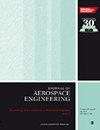利用试飞模拟评估护卫舰机库形状修改对直升机回收的影响
IF 1.1
4区 工程技术
Q3 ENGINEERING, AEROSPACE
Proceedings of the Institution of Mechanical Engineers Part G-Journal of Aerospace Engineering
Pub Date : 2024-09-14
DOI:10.1177/09544100241282718
引用次数: 0
摘要
湍急的舰船气流会给直升机着舰飞行员带来巨大挑战。最近的一项研究建议对简单舰艇 SFS2 的机库进行改造,以改善甲板上的气流。为了评估建议的机库改装对直升机和飞行员的影响,使用时间精确的 CFD 计算了改装后舰艇上的非稳定气流,然后与全运动飞行模拟器相结合,让飞行员在 30 kt 至 50 kt 的风速下,在原舰艇和改装后舰艇的几何形状上进行甲板着陆。通过对着陆任务的飞行员工作量评级,以及记录飞行员的控制输入和直升机状态,评估了拟议修改的有效性。研究表明,机库改装带来了一些益处。在逆风中,直升机按照原来的 SFS2 运行时被认为处于 50 kt 的安全极限,而改装后的直升机在 50 kt 的风力下没有达到极限。在斜风中,原船的安全风速极限为 40 kt,而改装后的船为 50 kt。虽然改进不大,但确实是一个积极的结果。本文章由计算机程序翻译,如有差异,请以英文原文为准。
Evaluating the effect of frigate hangar shape modifications on helicopter recovery using piloted flight simulation
Turbulent ship airwakes can present a major challenge for a pilot landing a helicopter to the ship. A recent study has proposed modifications to the hangar of a simple ship, the SFS2, to improve the air flow over the deck. To assess the effect of the proposed hangar modification on the helicopter and pilot, the unsteady air flow over the modified ship has been computed using time-accurate CFD, and then integrated with a full-motion flight simulator for a pilot to conduct deck landings to the original and modified ship geometries in wind speeds from 30 kt to 50 kt. The effectiveness of the proposed modification was assessed through pilot workload ratings for the landing task, and by recording pilot control inputs and helicopter states. The study has shown that there are some benefits from the hangar modifications. In the headwind the helicopter was deemed to be at the safe limit at 50 kt when operating to the original SFS2, while the limit was not reached in the 50 kt wind for the modified ship. In an oblique wind, the safe wind speed limit was found to be 40 kt for the original ship and 50 kt for the modified version. Although the improvements are not substantial, they do represent a positive outcome.
求助全文
通过发布文献求助,成功后即可免费获取论文全文。
去求助
来源期刊

CiteScore
2.40
自引率
18.20%
发文量
212
审稿时长
5.7 months
期刊介绍:
The Journal of Aerospace Engineering is dedicated to the publication of high quality research in all branches of applied sciences and technology dealing with aircraft and spacecraft, and their support systems. "Our authorship is truly international and all efforts are made to ensure that each paper is presented in the best possible way and reaches a wide audience.
"The Editorial Board is composed of recognized experts representing the technical communities of fifteen countries. The Board Members work in close cooperation with the editors, reviewers, and authors to achieve a consistent standard of well written and presented papers."Professor Rodrigo Martinez-Val, Universidad Politécnica de Madrid, Spain
This journal is a member of the Committee on Publication Ethics (COPE).
 求助内容:
求助内容: 应助结果提醒方式:
应助结果提醒方式:


